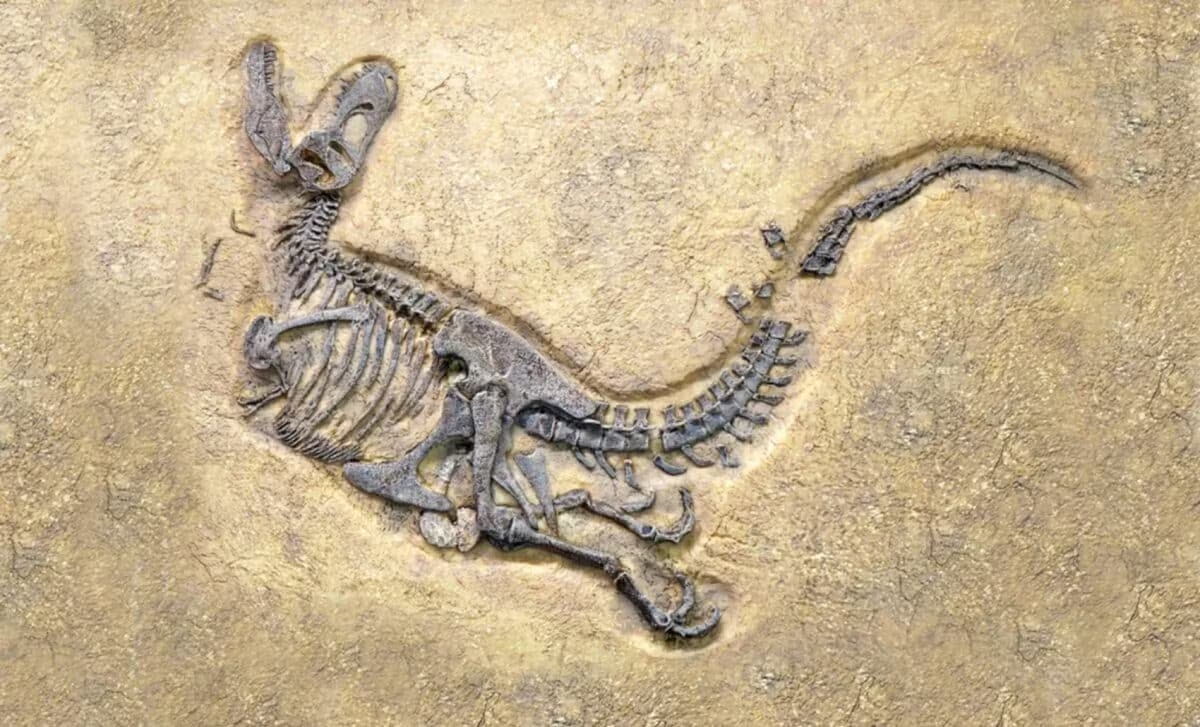A Century-Defining Paleontological Discovery
In a monumental finding that has redefined the landscape of British paleontology, researchers have announced the discovery of the most complete dinosaur fossil unearthed in the United Kingdom in over 100 years. This extraordinary specimen represents a newly recognized species, provisionally named Comptonatus, and provides an unprecedented window into the Mesozoic ecosystem of what is now Great Britain.
The fossil, an articulated skeleton, is remarkable not just for its age—dating back to the late Jurassic or early Cretaceous period—but for its exceptional state of preservation. Unlike the fragmented remains typically found in the UK, which often consist of isolated bones or teeth, this specimen retains much of its original structure, offering scientists a wealth of information previously unavailable.

The Anatomy of an Unprecedented Find
The significance of the Comptonatus discovery lies primarily in its completeness. While the UK has been a crucial site for dinosaur discoveries since the 19th century—including the first scientifically described dinosaur, Megalosaurus—these finds have historically been fragmentary. The UK’s geological history, marked by erosion and tectonic activity, means that soft tissues and fully connected skeletons rarely survive.
Initial assessments suggest the fossil is an iguanodontian or a close relative, a group of large, herbivorous dinosaurs common during the Cretaceous period. However, the unique features of the skeleton confirm it belongs to a genus previously unknown to science. Key details about the find include:
- Completeness: Estimated to be over 85% complete, a figure virtually unheard of for UK dinosaur remains.
- Articulation: Many bones remain connected in their natural anatomical positions, suggesting the animal was buried rapidly, likely in marine or estuarine sediments, minimizing scavenging and decay.
- Size: The individual is believed to have been a sub-adult, offering insights into the growth stages of this new species.
- Location: While the precise location is often kept confidential to prevent unauthorized digging, the find occurred in a region known for its rich sedimentary deposits from the Mesozoic Era.
This level of preservation allows paleontologists to study the dinosaur’s biomechanics, muscle attachments, and evolutionary relationships with far greater accuracy than isolated bones permit.
Unveiling the New Species: Comptonatus
The naming of the new species, Comptonatus, marks a pivotal moment in the study of British dinosaurs. The species name reflects the unique characteristics observed in its skeletal structure, particularly in the pelvic girdle and dental morphology, which distinguish it from established genera like Iguanodon or Mantellisaurus.
What the Fossil Reveals About the Cretaceous UK
The discovery challenges long-held assumptions about the diversity and distribution of large herbivores in the UK during the transition from the Jurassic to the Cretaceous periods. The environment of Britain at that time was vastly different from today—a complex landscape of islands, shallow seas, and coastal plains, often referred to as the Wealden Group environment.
Comptonatus likely played a significant role as a primary consumer in this ecosystem. Its robust build and specialized teeth suggest a diet of tough, fibrous vegetation, possibly including early flowering plants or conifers. The presence of a new, large herbivore indicates that the local environment was capable of supporting a diverse and complex food web.
“The completeness of this specimen is a game-changer for British paleontology,” stated a lead researcher on the project. “It allows us to move beyond speculation based on fragments and truly reconstruct the life, movement, and evolutionary lineage of a species that walked these lands 130 million years ago. This is the Rosetta Stone of UK dinosaur fossils.”

The Importance of Taphonomy
For experts, the story of Comptonatus is also a lesson in taphonomy—the study of how organisms decay and become fossilized. The articulated nature of the skeleton suggests a catastrophic burial event, likely a sudden flood or burial under sediment in a low-oxygen environment, which prevented the carcass from being scattered by scavengers or broken down by microbial action.
This specific taphonomic pathway is incredibly rare in the UK, where most fossils are found in highly disturbed or heavily weathered deposits. The quality of the find provides crucial data not only on the dinosaur itself but on the precise environmental conditions that existed in the region during the time of its death.
Britain’s Rich Dinosaur History
The UK holds a special place in the history of paleontology. The field itself was largely founded in the early 19th century based on discoveries made in England. However, subsequent finds in North America and China often overshadowed British discoveries due to the sheer size and completeness of the fossils found there.
Prior to Comptonatus, the most significant complete dinosaur finds in the UK were often associated with the Isle of Wight, a hotbed for Cretaceous dinosaur remains. Yet, even those finds rarely achieved the level of articulation and completeness seen in this new specimen.
A Timeline of Major UK Discoveries
- 1824: Megalosaurus – The first dinosaur ever scientifically described, based on fragmented remains found in Oxfordshire. This established the concept of ‘Dinosauria’.
- 1825: Iguanodon – Described by Gideon Mantell, based on teeth and bones found in Sussex. It was one of the three original genera used to define the Dinosauria group.
- Late 19th/Early 20th Century: Numerous fragmented finds, particularly on the Isle of Wight, including species like Polacanthus and various sauropods, but lacking a single, complete articulated skeleton.
- 2025: Comptonatus – The discovery of the most complete articulated skeleton in over a century, offering unparalleled anatomical detail.
This new discovery elevates the UK’s status in global paleontology, demonstrating that significant, world-class specimens can still be found within its borders, even after centuries of intensive searching.
Why Completeness Matters to Science
For paleontologists, a complete, articulated skeleton is the gold standard. Fragmentary fossils necessitate reconstruction based on related species, introducing potential errors. A complete specimen, however, allows for:
- Accurate Classification: Precise identification of unique skeletal features (autapomorphies) necessary to define a new species or genus.
- Biomechanical Modeling: Understanding how the animal moved, its gait, speed, and posture, by analyzing the joint surfaces and muscle attachment points.
- Growth Studies: Determining the age and growth rate of the individual, which is essential for understanding population dynamics.
- Evolutionary Relationships: Providing definitive data points for phylogenetic analysis, helping to map the evolutionary tree of the iguanodontian lineage across continents.
Implications and Future Research
The immediate focus for the research team is the meticulous preparation and scanning of the fossil. High-resolution CT scanning and 3D modeling will be used to create digital records of the skeleton, allowing for virtual reconstruction and analysis without risking damage to the fragile original material.
Expected Developments
- Full Scientific Description: A detailed paper describing the anatomy, classification, and significance of Comptonatus is expected to be published in a major peer-reviewed journal within the next year.
- Public Display: Plans are underway to prepare the fossil for public exhibition, potentially making it the centerpiece of a major UK museum collection, allowing millions to view this landmark discovery.
- Further Excavation: The discovery site will likely undergo further, careful excavation to determine if other associated remains or environmental clues can be recovered, potentially leading to the discovery of other individuals of the same species or associated fauna.

Key Takeaways
This landmark finding of Comptonatus is a testament to the enduring potential of British paleontology. The key facts that define the importance of this discovery are:
- Record Completeness: It is the most complete dinosaur fossil found in the UK in over a century, estimated to be over 85% intact and articulated.
- New Species: The specimen represents Comptonatus, a previously unrecognized genus likely belonging to the iguanodontian group.
- Scientific Value: Its exceptional preservation allows for unprecedented studies into the biomechanics, growth, and evolutionary history of large herbivores in the early Cretaceous period.
- Taphonomic Insight: The articulated nature of the find provides rare evidence of rapid burial and preservation conditions in the ancient UK ecosystem.
Conclusion
The discovery of Comptonatus is more than just a historical footnote; it is a profound scientific resource. By providing a nearly complete picture of a large dinosaur species that roamed the British Isles millions of years ago, researchers can now piece together a much clearer narrative of the region’s prehistoric past. This fossil ensures that the UK remains at the forefront of dinosaur research, promising years of detailed study that will enrich our understanding of life during the age of giants.
Original author: Melissa Ait Lounis
Originally published: November 22, 2025
Editorial note: Our team reviewed and enhanced this coverage with AI-assisted tools and human editing to add helpful context while preserving verified facts and quotations from the original source.
We encourage you to consult the publisher above for the complete report and to reach out if you spot inaccuracies or compliance concerns.

